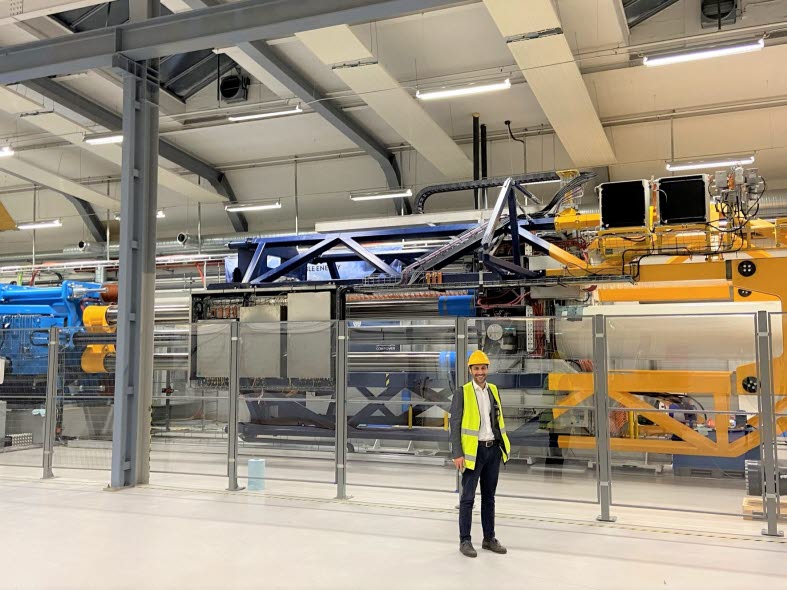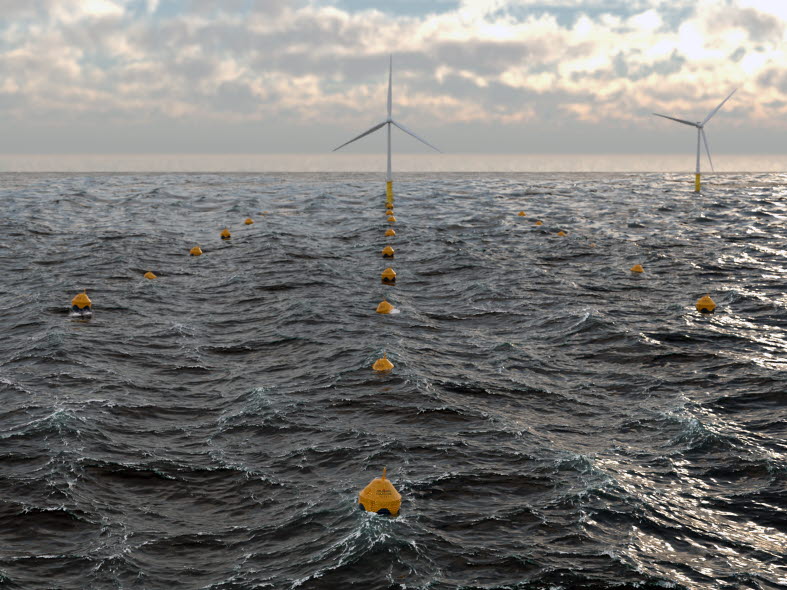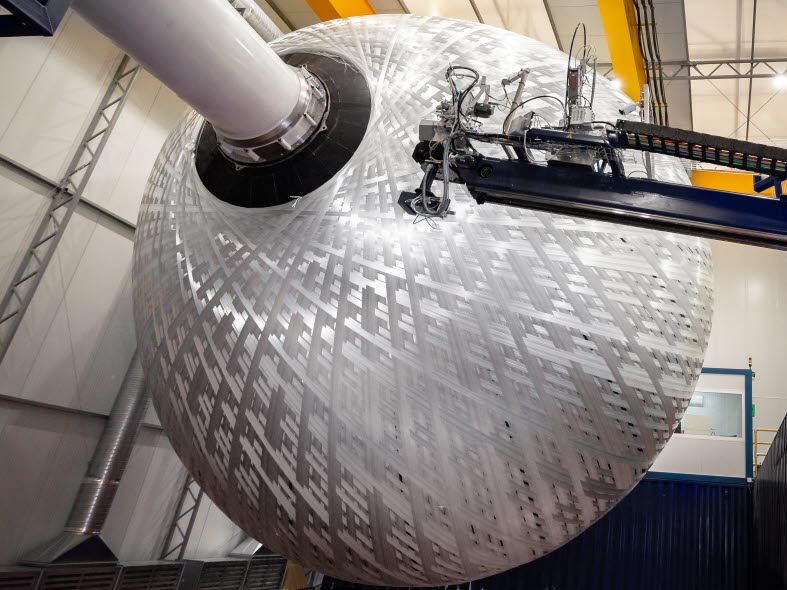CorPower Ocean Wave Energy Converter
Watch the video that illustrates how CorPower Oceans technology works.

You need to use a different browser. To be able to use our internet services, you can instead use one of these browsers: Apple Safari, Google Chrome, Microsoft Edge or Mozilla Firefox.
When cardiologist and inventor Stig Lundbäck and serial entrepreneur Patrik Möller met, Stig's ideas on wave energy gained momentum, and since then the company CorPower Ocean has developed to become a global leader in wave energy.
“Stig was a brilliant inventor who was constantly producing new ideas. He was also a typical inventor personality who preferred the initial idea phase over the long and systematic work in larger teams required to realise it,” says Patrik Möller, CEO of CorPower Ocean since the company's founding in 2012.

The basic principles for Stig Lundbäck's ideas can be found in a dissertation from 1986, where he describes the human heart's pump and autoregulatory function as a “Dynamic Adaptive Piston Pump (DAPP)”. That discovery was contrary to the notion at the time of the heart as a squeezing pump. It is also the foundation for much of what Stig Lundbäck subsequently dedicated his life to.
It was in 2011 when Stig Lundbäck first came into contact with InnoEnergy, a European initiative to support new companies in sustainable energy production. By that time Lundbäck had already spent a couple of years thinking about how his ideas on the heart's function could be used to extract energy from ocean waves.
Experts at InnoEnergy saw the potential of Lundbäck's ideas, but were not ready to proceed, as they realised that they needed to balance Lundbäck's steady stream of ideas with someone who could add more structure to the work and who had experience in building companies.
The man tapped for the assignment was Patrik Möller. He had previously spent more than ten years building up companies in the semiconductor industry after earning an engineering degree from Lund University and UC Berkeley, California. At the time, in 2011, he was ready for new challenges.
Together with InnoEnergy he started a project to research the potential more closely. This led to close contacts with a cadre of experts in various fields throughout Europe that had been involved in previous attempts in wave energy.
“In addition to his initial ideas, Stig's contribution was important in the company's early development. Without him there would not be any CorPower Ocean,” says Patrik Möller.
“The key to our success has then been the ability to attract additional inventions while building teams of experienced engineers and scientists who could combine multiple innovative technologies in a systematic approach. It has taken several generations of prototypes and millions of computer simulations, to develop these initial ideas into robust industrial technology.”
For wave energy to give a significant contribution to tackle climate change, the technology needs to be successful in two respects: it must be able to withstand ocean storms, and it must generate enough energy in relation to the size, weight and cost of the equipment used.
In simple terms it could be said Stig Lundbäck's invention addresses storm survival by protecting the Wave Energy Converter (WEC) in storms, in a comparable way that the blades of a wind power turbine pitch their blades in storms to avoid overloading.
After having verified storm survival in a first round of prototype tests, CorPower focused on the issue of how efficiency in electricity generation could be increased compared with known solutions. Patrik Möller found the answer in Norway. There, scientists had conducted tests with wave energy for a long time. Among them were Johannes Falnes and his colleague Dr. Jørgen Todalshaug , who at the time were active at NTNU (the Norwegian University of Science and Technology) in Trondheim.
Based on research into hydrodynamics for wave energy buoys that have been conducted since the 1970s, Jørgen Todalshaug hatched an idea on a new type of control technology that uses a negative spring function. In cooperation with CorPower he conducted various tests in which they combined this solution with the company's core technology.
It was highly successful, and through tank testing at Ecole Centrale Nantes they succeeded in showing how this combined technology could both withstand extreme storm waves while generation in normal waves was shown to be able to deliver five times as much energy in relation to the amount of machinery compared with previously known wave energy solutions. Since this breakthrough in 2014 the company has continued to refine and scale up the technology to commercial scale.
The balancing of variations of solar energy and wind power is one of the most important questions to solve in order to achieve fully renewable energy systems around the world.
Watch the video that illustrates how CorPower Oceans technology works.
Statistics from Enerdata show that more than 80 per cent of the world's energy production in 2022 was derived from fossil sources such as oil, coal and gas. This share needs to be dramatically reduced to reach the goal of a maximum 1.5 degree increase in the average global temperature, which 193 countries agreed on in the Paris Agreement in 2015.
The build-out of wind power and solar energy is in full swing in many places in the world, even if these still account for a small share of total power generation. The contribution from wave energy is essentially non-existent – so far.
A key characteristic of wave energy is that it delivers a much more even and more predictable generation profile, which means that it can be combined with wind and solar to deliver a stable mix of clean energy. The waves from the world's major oceans arrive at our coasts regardless of which direction the local winds are blowing or whether the sun is out at any given time.
“The balancing of variations of solar energy and wind power is one of the most important questions to solve in order to achieve fully renewable energy systems around the world,” says Patrik Möller. “To be able to deliver renewable electricity at all hours of the year to meet the expansion of electrification in the coming decades, a stable mix of clean energy sources is needed. Wave energy can help bring stability to the clean energy mix, taking on this critical role that fossil fuels have had historically.”
He sees major potential for wave energy especially on the west coasts of Europe, North and South America, Indonesia, India, southern and western Africa, and Australia. Many island nations also have good wave conditions – that is, swells that are created from multiple weather systems, over a long period of time across large oceans. The value of wave energy is largest in regions with such swell, that results in a consistent and complimentary production profile with little or no correlation with the wind or solar resource.
A number of independent studies show that wave energy has the potential to account for up 10 per cent of global electricity demand, i.e., somewhere around of 500 GW, or 2,300 terawatt hours (TWh), which is roughly as much as all of today's hydro power and more than all nuclear power capacity globally.
Since its start in 2012, CorPower Ocean has developed into a company that Patrik Möller today believes is the leader in its field, employing more than 80 people with 17 different nationalities. Jørgen Todalshaug , from NTNU, joined the company in 2015 as Lead Scientist, and it is also his ideas that form the foundation for the technology that is now referred to as WaveSpring, which is one of the cornerstones of the concept.

Leading energy companies such as Irish utility ESB, Energias de Portugal (EDP), Italian Enel Green Power and Irish Simply Blue Group are working with the company's technology and demonstration projects. The world's largest rig for dry testing of Wave Energy Converters has been built by CorPower Ocean in collaboration with ABB. It is located in the company's premises in Västberga in southern Stockholm.
“We are finalising stage four of our five-stage process for demonstrating wave energy as a robust source of clean energy. The first commercial scale WEC – C4 – is successfully installed in northern Portugal and has already shown proof of storm survivability. Now approaching the fifth stage with confidence and knowledge to bring it to utility scale,” says Patrik Möller.
The company has proven that the technology works in several phases with prototype tests and is now taking the step to commercial scale with the C4 device that is delivering electricity to the Portuguese grid. Several large energy companies are participating in the demonstration project and working in parallel to develop sites for commercial wave farms with the aim to have them in operation from 2027 and onwards.
In order for customers to be able to use traditional project financing for large, commercial wave farms, certification of availability and performance is desired from an independent third party. The C4 device and the next generation of production machines (C5) will gather at least the 8,000 hours of operational data from the installation in Portugal that are required for type certification.
Early financing for the project came from EIT InnoEnergy and the Swedish Energy Agency, and over the years public investors from Sweden, Portugal, Scotland and the EU have supported the company. Since the start, the ownership base has been broadened and today includes, in addition to the founders, several investors, including SEB's venture capital unit SEB Greentech VC, CoreSpring Technology, ALMI Invest Greentech, InnoEnergy and Sierra Global.

In 2020, floating offshore wind had a major commercial breakthrough. Extensive plans have now been drawn up for floating wind farms around the world. For wave energy this is an opportunity to accelerate the rollout, since the two complement each other and can together provide more steady generation that can be sold at a higher value. Combined wind and wave energy farms can also share the cost of electric infrastructure, get higher utilisation of ocean area, and benefit from joint permitting processes and service teams for maintenance.
Patrik Möller describes how clusters of CorPower Ocean's Wave Energy Converters, called CorPacks, can be situated directly adjacent to rows of offshore wind turbines. Each CorPack with 25 buoys will generate approximately 10 megawatts of electricity. This corresponds roughly to the capacity of a modern offshore wind turbine. CorPower's technology uses the ocean surface efficiently and can deliver approximately three times more capacity per square kilometre compared to offshore wind.
Wave farms can also be installed stand-alone. A key advantage is that the buoys are small in relation to wind turbines and can thereby be situated closer to the coast without obstructing views or the ocean environment, which facilitates permitting processes. Wind turbines are often positioned at least 20 kilometres offshore, while wave energy buoys can be situated just a couple of kilometres offshore. This makes the infrastructure for transmission to land cheaper and access to service faster.
We are building CorPower Ocean into a new Vestas for wave energy and aim to be a significant industrial operation in Sweden, Portugal and in several other places in Europe.
With the first commercial scale C4 machine being launched in 2022, CorPower Ocean is working to ensure delivery capacity to be able to scale up from prototypes to volume production. The core of this system – the so-called Power Take-Off (drive train) – will be made in Sweden with a combination of own assembly and subcontracted assembly partners. CorPower is cooperating with, among others, Blue Future in Kristinehamn, who are prepared to scale up its assembly capacity.

Much of the other manufacturing will be conducted locally near the sites where the equipment will be installed. The buoy hulls, with a diameter of 9 metres, are made using an innovative technology in which composite material is woven in a fully automated process. An innovative concept comprising mobile factory cells has been developed and demonstrated on the C4 buoy in Portugal, where CorPower has built a team of composite manufacturing experts.
Delivering wave farms to customers, these mobile factory cells will be moved to the customer site, produce the number of hulls needed for the project, and then be moved over to the next customer site. This will enable cost-efficient manufacturing and local jobs while at the same time avoiding substantial costs and transport-related carbon emissions.
The other equipment for mooring and anchoring the buoys and the infrastructure for transmitting electricity to land will also be manufactured by local supply chain close in the region of the respective wave farm. These subsystems are also based on proprietary technology developed by CorPower.
With all the pieces in place, in the coming years CorPower Ocean aims to evolve from a development company to a major industrial player in energy generation.
“We are building CorPower Ocean into a new Vestas for wave energy and aim to be a significant industrial operation in Sweden, Portugal and in several other places in Europe. We are well on our way. This year our focus has been to get our first commercial scale machine deployed in Portugal and now we will prove what no one has so far been able to prove, that we can utilise the oceans to provide clean, reliable, and cost competitive electricity at scale,” says Patrik Möller.
Like CorPower, the Danish wind power company Vestas is a world leader in its area and is currently valued at around 21 billion euros on the Copenhagen Stock Exchange.
Read more about CorPower Ocean at: corpowerocean.com
Article originally published on 25 October 2022. Updated on 9 November 2023.
Text: Magnus Hansson
SEB Greentech Venture Capital is a unit within SEB that invests in green technology, focusing on transformative ideas that promise substantial impact in reducing greenhouse gas emissions or in preventing transgression of the planetary boundaries. They can invest in hardware, software and technology platform solutions, in sectors ranging from renewable energy, energy storage, water and agricultural technology, circular business models, to waste management.